Wednesday, 28 September, Budapest, Hungary, and the changing of the guard
Written 24 November 2022
Our ship pulled into Budapest at breakfast time. Now that we were in Hungary, the cheeses on the breakfast buffet changed: one was a Saga style blue cheese, another was Bonifaz (a soft sliced cheese), and third was a thick slice from a cylindrical chevre that was pretty clearly Bcûheron, a favorite of mine. An improvement over the old assortment.
And today was the day that many passengers (those signed up only for Viking's Passage to Eastern Europe) disembarked and about 50% more (those signed up only for Viking's Grand European Tour) joined us, bringing the ship's population up to about 160.
But Viking has thought all this through, and during the morning's carefully orchestrated chaos, when buses, vans, and taxis came and went taking departing passengers to the airport, train station, cruise extension hotels, etc., we were scheduled for Panoramic Budapest, an overview tour of the town(s), mostly by bus.
Getting to the bus, however, proved to be an operation. We were moored outboard of another ship, and because it wasn't one of Viking's, the decks didn't line up. So to get to the shore, after going down the lower deck to get our hats, camers, quietvoxes, etc., we had to go up three flights, cross our sundeck, across the other ship's sundeck, down three flights of stairs, down a gangway onto the ponton, up another long gangway, and finally onto the bus.
Written 27 November 2022
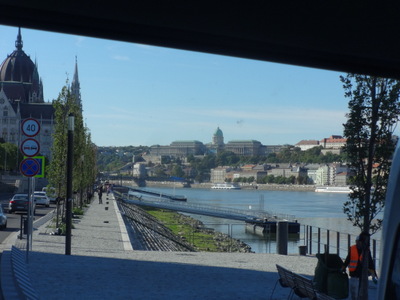
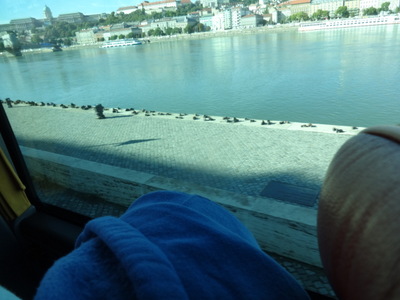 We were moored on the Pest side, so our tour started there. We were already quite close to the center of things, so one of our first views was this shot (at the left) that captures both the parliament building at the left edge and, across the river in Buda and farther away, the palace. The parliament is that beautiful spiky building with the red domes that features so prominently in the Viking TV commercials. I didn't manage to catch it with the sun on the red roofs, but it was really impressive anyway.
We were moored on the Pest side, so our tour started there. We were already quite close to the center of things, so one of our first views was this shot (at the left) that captures both the parliament building at the left edge and, across the river in Buda and farther away, the palace. The parliament is that beautiful spiky building with the red domes that features so prominently in the Viking TV commercials. I didn't manage to catch it with the sun on the red roofs, but it was really impressive anyway.
Only a little farther along was the famous Shoes on the Danube Bank memorial. Many pairs of life-size bronze shoes are permanently installed along the river's edge, commemorating the victims of the nazis' practice of marching Jews to the riverbank, making them take off their shoes, then shooting them and pushing their bodies into the river.
As we drove, our guide filled us in on basic information about the city. The left, Pest, side is flat and is home to the business district and the government. The right, Buda, side is hillier and greener and much more residential. In the middle is Margaret Island. Margaret was the daughter of a king, the "second founder" of the country (about whom more below), born during the 13th-century Mongol invasion of Hungary. Her parents promised that, if the Mongols were defeated, they would dedicate her to the church. The Mongols left, so at age 3, Margaret was placed in a Benedictine monastery nearby. At age 9, she was transferred to the Monastery of the Blessed Virgin, which her parents founded for the purpose on the island between Buda and Pest. When she was of marriageable age, her father tried to marry her off to some convenient prince, but she refused, choosing instead to become a nun, and spent the rest of her life there. The island is now a park, and the ruins of the monastery can be visited. Several attempts to have Margaret canonized failed, but the one in 1943 succeeded.
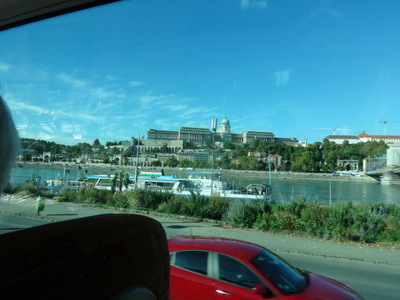
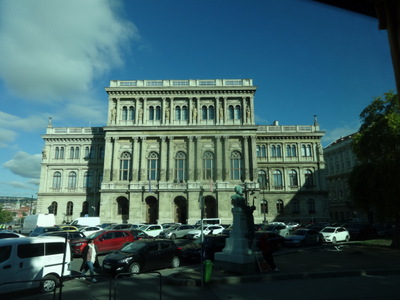 Here, at the left, is a nearer view of the palace, once a royal residence but now a museum. It gives its name to that whole section of Buda, the "palace district." The double column that seems to rise to the left of the dome is just the top of a lamp post, or maybe small cell tower, on the near side of the river, which I didn't notice when I took the photo.
Here, at the left, is a nearer view of the palace, once a royal residence but now a museum. It gives its name to that whole section of Buda, the "palace district." The double column that seems to rise to the left of the dome is just the top of a lamp post, or maybe small cell tower, on the near side of the river, which I didn't notice when I took the photo.
At the right is the Hungarian Academy of Sciences, built by Istvan Széchenyi de Sárvár-Felsövidék (1791–1860), often refered to as "the greatest Hungarian." A statue of him stands somewhere nearby, but I'm not sure which of the ones I photographed (and those I didn't) is it.
He also built the city's first bridge over the Danube, the Chain Bridge, in 1849. It was closed for renovation while we were there. In the 19th century you could often cross the frozen Danube on horseback; now the most recent time it froze was in the 1960s. But during Széchenyi's life, there was a winter when the river was impassible, and Széchenyi was stranded on the Pest side, while his father fell ill and died on the Buda side. He paid for the bridge so such a thing wouldn't happen again.
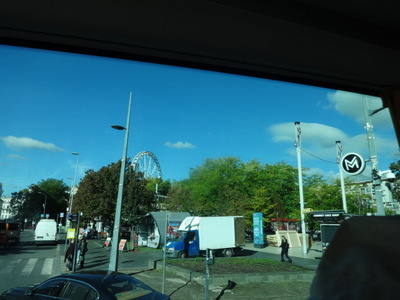
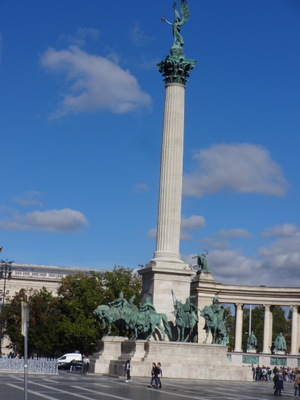 At the left here is a rather cluttered view of part of Elizabeth Square, a park with a former royal residence and, now, the Budapest Eye ferris wheel. Elizabeth (nicknamed Sisi) was a minor royal of Bavaria who, at age 16, married emperor Franz Joseph of Austria. Their residence in Bupapest was one of Sisi's favorites, and she spent a lot of time there with her husband and children and even spoke fluent Hungarian. She was very popular with the locals. Unfortunately, she was assassinated by an anarchist in Geneva in 1898, at the age of 61. The residence and its grounds then became a park in her memory.
At the left here is a rather cluttered view of part of Elizabeth Square, a park with a former royal residence and, now, the Budapest Eye ferris wheel. Elizabeth (nicknamed Sisi) was a minor royal of Bavaria who, at age 16, married emperor Franz Joseph of Austria. Their residence in Bupapest was one of Sisi's favorites, and she spent a lot of time there with her husband and children and even spoke fluent Hungarian. She was very popular with the locals. Unfortunately, she was assassinated by an anarchist in Geneva in 1898, at the age of 61. The residence and its grounds then became a park in her memory.
Then, at the end of a long straight avenue from Elizabeth Square, we came to Heroes' Square, at the center of which stands this tall column topped by the archangel Gabriel holding the apostolic double-armed cross and the royal crown of Hungary.
Behind the angel is a semicircular row of columns, between which stand notable personages of Hungarian history, so this seems like a good place to try to organize what I learned about that history and those personages.
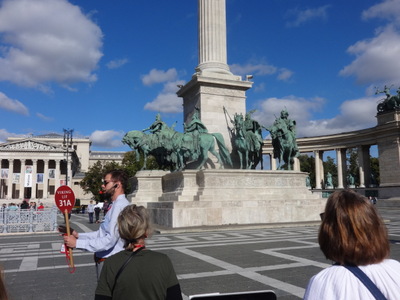
 Here's a closer shot of the base of the column, which features statues of seven tribal leaders. The one in front is Árpád, who in the year 896 managed to unify the seven Hungarian tribes to form Hungary. His statue was made first, when the square was built in 1896 to mark the country's millenium. The others were added later and are by a different sculptor. Our guide pointed out repeatedly that, if you wonder when something in Budapest was built, 1896 is always a good guess—the millenium was a Big Deal, and they built a lot of stuff. He also pointed out that the horses those tribal leaders would really have been riding were stocky little Asian horses, not the noble steeds the sculptor chose to portray.
Here's a closer shot of the base of the column, which features statues of seven tribal leaders. The one in front is Árpád, who in the year 896 managed to unify the seven Hungarian tribes to form Hungary. His statue was made first, when the square was built in 1896 to mark the country's millenium. The others were added later and are by a different sculptor. Our guide pointed out repeatedly that, if you wonder when something in Budapest was built, 1896 is always a good guess—the millenium was a Big Deal, and they built a lot of stuff. He also pointed out that the horses those tribal leaders would really have been riding were stocky little Asian horses, not the noble steeds the sculptor chose to portray.
The building in the background, with banners between its columns, is the Museum of Fine Arts. It was featuring an exhibition of Matisse, but we didn't have a chance to go.
At the right is a photo of the gap between the two halves of the semicircle of heroes. The two chariots on top, facing each other across the gap, represent war (on the left) and peace (on the right).
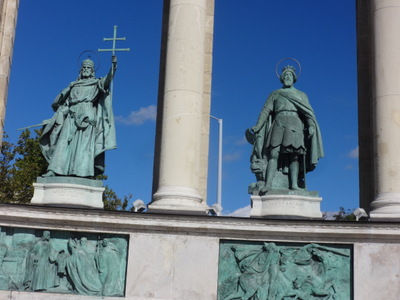 About 100 years after Árpád, in the year 1000, came his descendent Stephen I, the first official king of Hungary. The pope made him king in exchange for converting the whole region to Christianity. So he's the "first founder" of the kingdom of Hungary. He was without successor, so years of struggle for the throne ensued. Finally, things stabilized under Ladislaus I, who, like Stephen I, was later canonized. The photo at the left shows the two of them (Stephen on the left, Ladislaus on the right).
About 100 years after Árpád, in the year 1000, came his descendent Stephen I, the first official king of Hungary. The pope made him king in exchange for converting the whole region to Christianity. So he's the "first founder" of the kingdom of Hungary. He was without successor, so years of struggle for the throne ensued. Finally, things stabilized under Ladislaus I, who, like Stephen I, was later canonized. The photo at the left shows the two of them (Stephen on the left, Ladislaus on the right).
Ladislaus's son, Coloman (the Learned)forbade the hunting of witches, declaring "there's no such thing as witchery."
I don't seem to have gotten a photo of the next two notables, Bela IV and his son Stephen V, who fought off the Mongol invasion of 1241. Bela IV was the father of St. Margaret, she of the island. He is considered the "second founder" of the state.
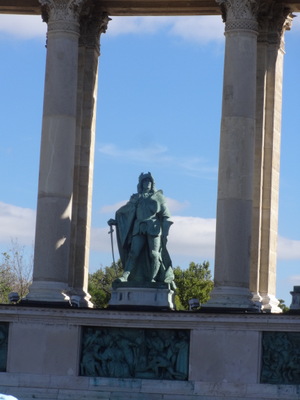
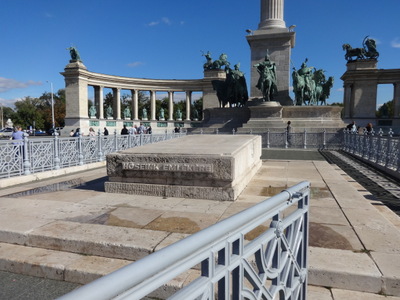 The house of Árpád was replaced a few kings later, and half a dozen houses came and went (including Luxembourg, Anjou, and Hapsburg) before Matthias (the Just) who became king in 1458. His second marriage was to an Italian princess. He brought Italian influence and is called the Renaissance King of Hungary. His life is the basis of many Hungarian folk tales as a result of his practice of going around incognito (as a farmer, soldier, hunter, etc.) to see through the peoples' eyes. He was also something of a fashionista, as you can see from his photo at the left here.
The house of Árpád was replaced a few kings later, and half a dozen houses came and went (including Luxembourg, Anjou, and Hapsburg) before Matthias (the Just) who became king in 1458. His second marriage was to an Italian princess. He brought Italian influence and is called the Renaissance King of Hungary. His life is the basis of many Hungarian folk tales as a result of his practice of going around incognito (as a farmer, soldier, hunter, etc.) to see through the peoples' eyes. He was also something of a fashionista, as you can see from his photo at the left here.
In front of the square's central column is the Memorial Stone of Heros, shown in the right-hand photo.
Adjacent to the square is a large castle that the guide told us never served any purpose. It was built as a temporary decorative structure for festivities (probably in 1896) and was originally all wooden, but it became so popularized that it's been made permanent. In front of it was a large plaza studded with shallow puddles. The guide said it was in transition just now. In the summer, it's a shallow lake. In winter, a skating rink.
While we stood admiring the square, three big white unmarked buses with a police escort and sirens went by. We never found out a propos of what. And as we left, less and less of the square was available for strolling, because truckload after truckload of dirt was being brought in and dumped there, while crews were setting up crowd-control barriers around the edges. The National Gallop, a sort of Hungarian rodeo, is coming up in the next few days; the square will be completely covered with dirt and obstacles for the purpose. I fear that the people who took the next day's panoramic tour would see a very different place!
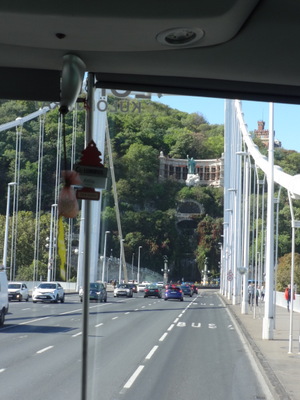
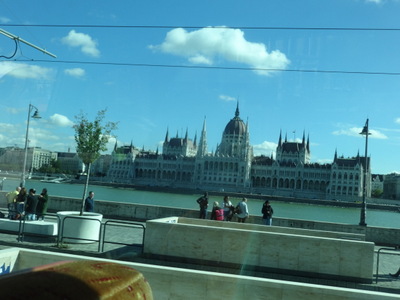 Next (well, after more scenic driving through Pest during which notable buildings went by too fast for me to get good photos or take note of their details), we crossed over to the Buda side. Here at the left, framed between the railings of the bridge we were crossing, is a monument that I think is a memorial for St. Gerard (St. Gellert), who was martyred there. He was an Italian bishop who came to town to be the first bishop of Hungary (soon after its conversion to Christianity). He was helping to subdue a pagan uprising, but the pagans put him in a barrel studded with nails and rolled him down the rocky hill to the river. He did not survive the experience.
Next (well, after more scenic driving through Pest during which notable buildings went by too fast for me to get good photos or take note of their details), we crossed over to the Buda side. Here at the left, framed between the railings of the bridge we were crossing, is a monument that I think is a memorial for St. Gerard (St. Gellert), who was martyred there. He was an Italian bishop who came to town to be the first bishop of Hungary (soon after its conversion to Christianity). He was helping to subdue a pagan uprising, but the pagans put him in a barrel studded with nails and rolled him down the rocky hill to the river. He did not survive the experience.
And at the right is a view of the entire parliament from the Buda side. Again, I couldn't catch it with the sun on it, but it's still a magnificent building. When it was in the planning stages, a contest was held for the best design. The parliament building was the winner, but the second- and third-place designs were also built, behind it, and are now in use for other purposes.
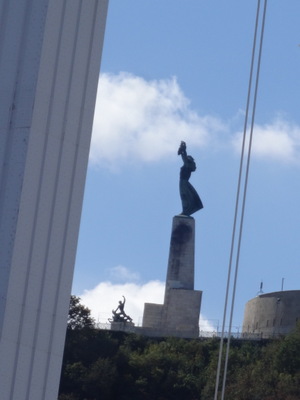
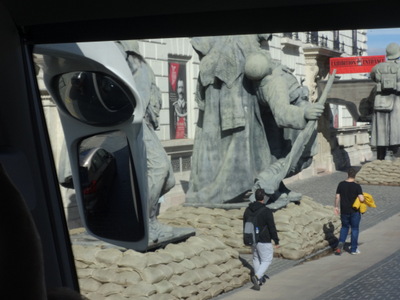 At the very top of Gellert Hill is a fortress called the "citadella," which we didn't get to visit. But it's topped by a huge statue of a woman holding aloft a palm leaf, called the Statue of Liberty. It dates from communist days, and she used to have a warlike male companion, but when communism ended, the city decided to get rid of the soldier but to keep the more peaceful woman as a war memorial.
At the very top of Gellert Hill is a fortress called the "citadella," which we didn't get to visit. But it's topped by a huge statue of a woman holding aloft a palm leaf, called the Statue of Liberty. It dates from communist days, and she used to have a warlike male companion, but when communism ended, the city decided to get rid of the soldier but to keep the more peaceful woman as a war memorial.
A major problem with bus tours in cities is that you pass many very interesting things that are too close for effective photography. For example, in Buda, we drove past these giant figures of 20th century soldiers, which I could fit only a fraction of into the frame. The guide said they were a propos of a special exhibition on World War II.

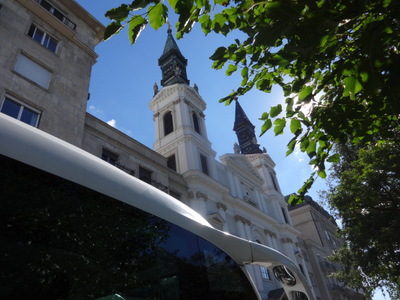 Here are two church steeples/towers we passed. The left-hand one says "gothic cathedral" to me, and around here "St. Stephen's" is always a good guess.
Here are two church steeples/towers we passed. The left-hand one says "gothic cathedral" to me, and around here "St. Stephen's" is always a good guess.
The other is later, more baroque-ish, so I'm guessing it's the "inner city parish church" that we visited next. It's apparently officially known as Church of Our Lady, but everyone just calls it the inner city parish church. During the Turkish invasion, this church, originally Roman Catholic, was converted to a mosque. They painted over all the frescos with white. It's long since been converted back, but a "mihrab" (a niche indicating the nearest point to Mecca, toward which one faces to pray) is still there, in the southeast wall> Liszt lived for six years in a monastary next to this church. He did not play here, but he took good care of the all-male choir.

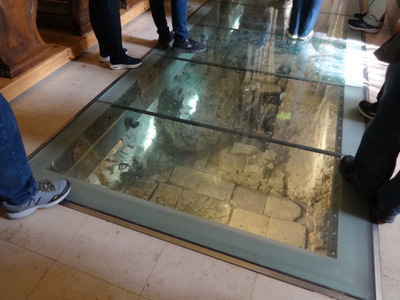 The guide told us the frescos had been restored, but maybe I wasn't looking in the right place, because I saw mostly plain yellow walls.
The guide told us the frescos had been restored, but maybe I wasn't looking in the right place, because I saw mostly plain yellow walls.
At the right is a glass-covered view down into part of the Roman ruins that underlie the church. They weren't church foundations but part of a military installation.
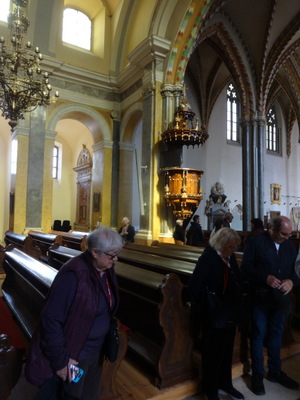
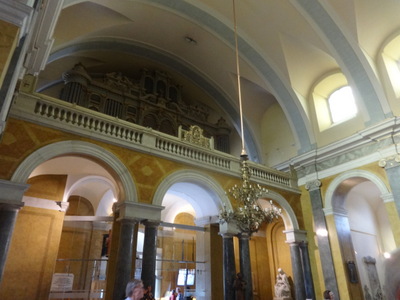 Here are the pulpit (left), made of some glowing golden wood, and the organ (right).
Here are the pulpit (left), made of some glowing golden wood, and the organ (right).

 A view down into a different section of Roman ruins (left) and the view down the length of the choir toward the altar (right).
A view down into a different section of Roman ruins (left) and the view down the length of the choir toward the altar (right).
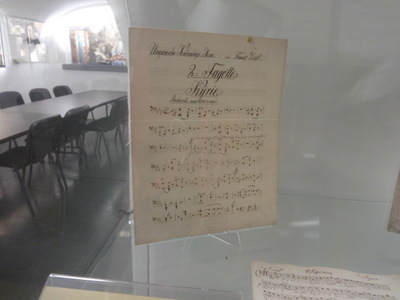
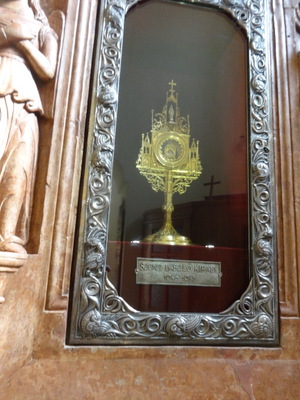 Downstairs, in the crypt was a small museum with a section of "musical treasures," like this manuscript page by Liszt (left), and some silver and gold, like this monstrance containing relics of St. Ladislaus, that king who got things back under control after Stephen I died.
Downstairs, in the crypt was a small museum with a section of "musical treasures," like this manuscript page by Liszt (left), and some silver and gold, like this monstrance containing relics of St. Ladislaus, that king who got things back under control after Stephen I died.
Written 28 November 2022
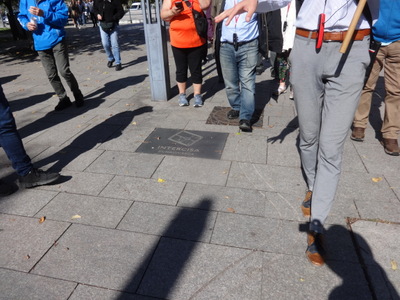
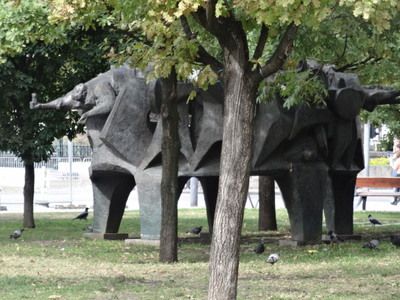 On the plaza outside the church, the shape of the Danube, with all its meanders, is etched into the sidewalk, and dark-colored square plaques are set into the ground alongside it, marking the locations of Roman garrisons. At the left here, you can see part of the river course. It passes between the shadow of the guide's hand and the forward shoe of the guy in jeans, then disappears under the guide's two-tone front shoe. The dark-gray square marks "Intercisa." I think the other dark square, under the back foot of the guy in jeans, is just a man-hole cover.
On the plaza outside the church, the shape of the Danube, with all its meanders, is etched into the sidewalk, and dark-colored square plaques are set into the ground alongside it, marking the locations of Roman garrisons. At the left here, you can see part of the river course. It passes between the shadow of the guide's hand and the forward shoe of the guy in jeans, then disappears under the guide's two-tone front shoe. The dark-gray square marks "Intercisa." I think the other dark square, under the back foot of the guy in jeans, is just a man-hole cover.
Nearby was the piece of modern (1971) art shown at the right, which is about 5 feet tall.. When I asked the guide about it, he said dismissively that it was "something to do with the Romans" and seemed not to want to talk about it. From other sources (I love the internet!), I learned that it commemorates an attack by the Sarmatians on Pest, called Contra Aquincum at the time. In the process of searching for information on it, I also found it on a site listing the ugliest monumental art, but I sort of like it. It used to be the centerpiece of a fountain but was later relocated.
In the course of our morning's tour, we several times drove by the central Budapest synagogue, but always too close for a decent photo. Its entrance is at the corner of a building and is quite handsome, but I could never get a sense of the actual size and shape of the building, as it wasn't freestanding but incorporated into solid blocks of city buildings.
According to our guide, it has a capacity of 3000 and is the largest synagogue in the world except for one at the corner of Central Park in New York City. It incorporates a museum as well as and a metal "emanual tree" and a cemetery in its interior courtyard. (If you just Google "emanuel tree budapest" you can see a photo; it's gorgeous.) The synagogue is not orthodox, so it even has has an organ. The congregation hires a gentile to play it, since Jews are not supposed to work on the the sabbath.
Apparently, Tony Curtis visited Budapest several times, supported maintenance and renovation of the synagogue, and formed a foundation to maintain it. The guide gave us the impression that Curtis was from Budapest and assured us that he had a lot of trouble getting rid of his Hungarian accent when he broke into movies. From other sources, I learn that Curtis was actually born in New York City (of parents from Hungary), that he spoke only Hungarian until he was 6, but that the accent he had to get rid of later was not Hungarian but Bronx.
The guide also tried to claim Estée Lauder, but she too was New York born, raised by a Hungarian mother.
More stuff the guide talked about:
The Budapest ghetto, now still the Jewish quarter, was the 7th district, also called Elizabeth Town, I think because it was in the area of Elizabeth Square.
- The street plan of Pest is organized as a central boulevard and concentric arcs, The central boulevard ends in Heroes' Square.
- We drove by a famous bronze statue of Sisi strolling with an umbrella, but I didn't get a photo.
- Austro-Hungarian emperor FRanz Josef (Sisi's husband) was really annoyed that the Budapest opera house rivaled that of Vienna in beauty, but he declared that, if his money was going to finance it, it certainly couldln't mbe made any larger than the Viennese one.
- We drove by FRanz Liszt square,. The Franz liszt academy is down at one end of it, the largest in Hungary.
- The intersection called Kodály Circus is named for Zoltan Kodály, who used ot live in one of the houses there. He introduced solfege to Hungarians.
- Transylvania was part of Hungary before WWI, and the Hungarians were still really mad that when things were divided up after that war, Transylvania was given to Romania.
- In 1956, the Hungarians mounted an uprising against communism. A giant statue of Stalin was pulled down and smashed into tiny pieces, which people picked up and took home as souvenirs. Unfortunately, that rebellion came to nothing, and the leaders had to flee.
- We drove by a high school where John von Neumann was a student, as were the inventor of Rubic's cube and the inventor of the refrigerator.
- Sections of the 7th district are still in ruins, and people (especially young people) have occupied the ruins and turned them into bars, so they're called "ruin bars." They're popular for bachelor parties. They tend to be decorated in very ramshackle style, and the guide said that some use old Amerian cars as restaurant booths. They do—I looked it up (I love the internet!) and saw photos.
- From the 150-year Ottoman occupation, Hungarians took paprika, tulips, and the Turkish bath culture.
- The yellow bridge is the city's most important bridge.
- At some point in its history the cross on top of the holy crown of Hungary got accidentially tilted (it's case may have been closed on it too hastily), and it has remained that way ever since.
- August 20 is St. Stephen's day
- The Roman name for what is now Hungary was Pannonia. Buda and Pest were Aquincum and Contra Aquincum (respectively, I think).
- We didn't get to visit the great market hall, but the guide told us that the main floor was mainly for food and that textiles, dishes, and whatnot were upstairs.
- St. Elizabeth of Hungary was married at age 14 to a much older prince, and they went up to Germany and lived in the Warburg castle. She regularly delivered bread to the poor, even though her husband forbade it. When he caught her at it one day, and she was forced to show him the contents of her basket, the bread had miraculously turned to roses, so he couldn't reprimand her. The roses changed back to food once the prince was gone.
And then it was only lunch time!
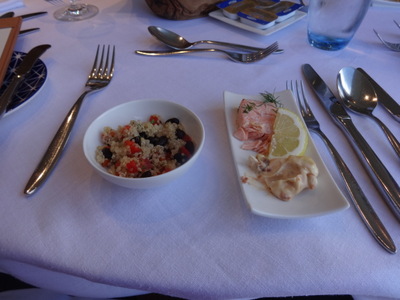
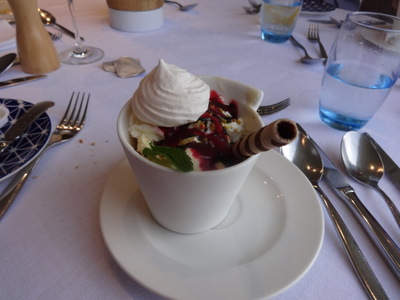 The "fine print" appetizers (the ones listed on the menu only as "our daily selection from the cold appetizer and chef's live station) were especially good. The quinoa and black bean salad was great, but the cold poached salmon with mayo was terrific.
The "fine print" appetizers (the ones listed on the menu only as "our daily selection from the cold appetizer and chef's live station) were especially good. The quinoa and black bean salad was great, but the cold poached salmon with mayo was terrific.
For my main course, I was tempted by the sesame tuna tataki bowl, but even more so by the roast beef and herbed cream cheese sandwich on crusty baguette with lettuce, tomatoes, and sprouts. Yummy.
For dessert, I passed up the apple compote tart with caramel sauce for the Dame Blanche: vanilla ice cream chocolate and raspberry sauces. The little round puff on top is not whipped cream but a crispy meringue.
We had no excursion booked for the afternoon. Viking offered the option of a bus shuttle into the center of town, in case we wanted to spend free time there, but I set up my little folding computer table off to one side of the reception desk to work on this diary and to wait for our traveling companions, who would be joining us for the remainder of the cruise.
Ron and Sallie McQuaid are neighbors of ours at Westminster Oaks, the old-folks home where we live in Tallahassee, Florida. Ron is ex-military, so they've lived all over the world, including a stint in Germany. They were looking forward to at least passing close to some of their old haunts. They showed up about 2:30 pm, having already spent a day or two in Budapest independently. They repaired to their stateroom (a couple of decks above ours) to unpack and settle in while a resumed waiting.
Despite my vigilance, David's younger sister, Janet Thistle Fox from Houston, managed to get by me unnoticed. An hour or so later, I got a text from her, saying that she was lounging on the Aquavit Terrace and asking where I was. I immediately joined her there, where she declared that she had found her home away from home—and sure enough, for the rest of the cruise, when she wasn't at meals, on an excursion, or sleeping, she was there on the terrace, basking in the sun in one of its comfy rocking chairs.
We all met again at the predinner briefing, where we learned that several of the senior crew, including the captain, were rotating off the ship (northern European Viking staff work something like four weeks on and two weeks off). Our new captain was Ksaba Szabo. Fortunately, our two favorite staff members, Program Director Marek and Maïtre d' Aleksandra will be staying with us all the way to Amsterdam.
We also learned that, because a lot of new passengers had joined us, dinner would be delayed while we all went through the life jacket drill again.
But at 7:15 pm, as the ship cast off to change to a different anchorage in Budapest, we all got together again in the dining room.
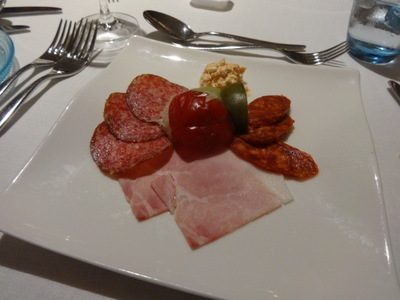
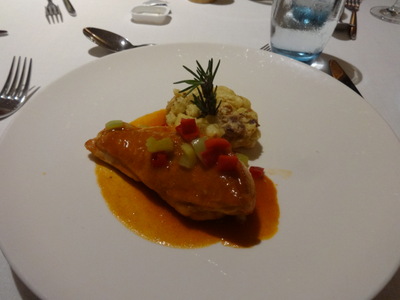 I started with the regional-specialty appetizer—this plate of marinated roasted peppers and cold cuts. David had the "traditional chicken paprikash."
I started with the regional-specialty appetizer—this plate of marinated roasted peppers and cold cuts. David had the "traditional chicken paprikash."
I was in a quandary over the main course. I wasn't interested in the vegan bean chili, but I couldn't be sure whether the "seared sea bass" would be sustainably harvested Dicentrarchus labrax or deplorably overexploited and soon to be endangered Dissostichus eleginoides, so rather than making a scene by insisting that the waiter find out, I just went for the always-available ribeye steak. It was delicious, but Ron ordered the sea bass, which was clearly Dicentrarchus and was grilled to perfection. I should have had
more faith in the Viking kitchen.
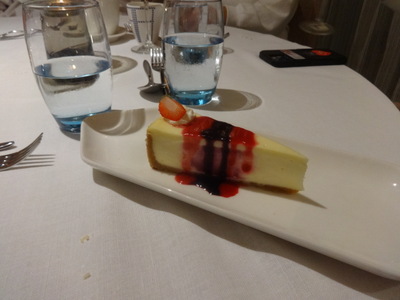
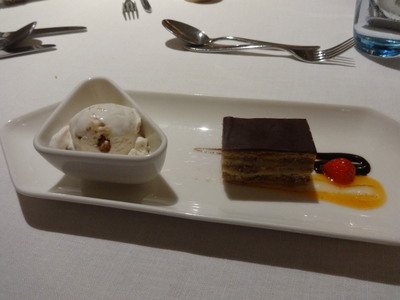 For dessert, Ron ordered the New York cheesecake with berry coulis
For dessert, Ron ordered the New York cheesecake with berry coulis
I chose the regional-specialty dessert: layered walnut and chocolate cake.
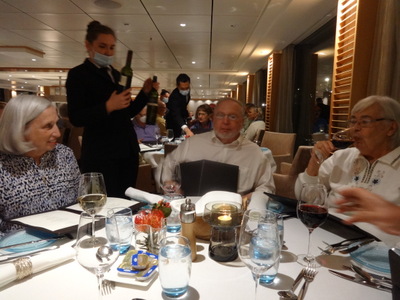
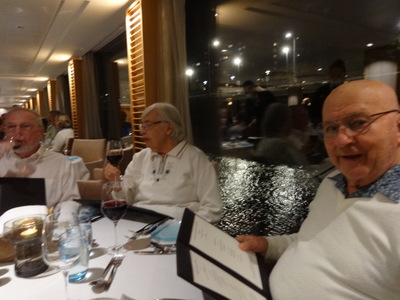 Here we all are, ordering our dinner and tasting the wines.
Here we all are, ordering our dinner and tasting the wines.
At the left (left to right), David's sister Janet, David, and Sallie. At the right (left to right), David, Sallie, and Ron.
We were all pretty tired—especially Jan, who had flown all the way from Houston that day—so we didn't stay for the after-dinner music in the lounge.
Previous entry
List of Entries
Next entry

 We were moored on the Pest side, so our tour started there. We were already quite close to the center of things, so one of our first views was this shot (at the left) that captures both the parliament building at the left edge and, across the river in Buda and farther away, the palace. The parliament is that beautiful spiky building with the red domes that features so prominently in the Viking TV commercials. I didn't manage to catch it with the sun on the red roofs, but it was really impressive anyway.
We were moored on the Pest side, so our tour started there. We were already quite close to the center of things, so one of our first views was this shot (at the left) that captures both the parliament building at the left edge and, across the river in Buda and farther away, the palace. The parliament is that beautiful spiky building with the red domes that features so prominently in the Viking TV commercials. I didn't manage to catch it with the sun on the red roofs, but it was really impressive anyway.
 Here, at the left, is a nearer view of the palace, once a royal residence but now a museum. It gives its name to that whole section of Buda, the "palace district." The double column that seems to rise to the left of the dome is just the top of a lamp post, or maybe small cell tower, on the near side of the river, which I didn't notice when I took the photo.
Here, at the left, is a nearer view of the palace, once a royal residence but now a museum. It gives its name to that whole section of Buda, the "palace district." The double column that seems to rise to the left of the dome is just the top of a lamp post, or maybe small cell tower, on the near side of the river, which I didn't notice when I took the photo.
 At the left here is a rather cluttered view of part of Elizabeth Square, a park with a former royal residence and, now, the Budapest Eye ferris wheel. Elizabeth (nicknamed Sisi) was a minor royal of Bavaria who, at age 16, married emperor Franz Joseph of Austria. Their residence in Bupapest was one of Sisi's favorites, and she spent a lot of time there with her husband and children and even spoke fluent Hungarian. She was very popular with the locals. Unfortunately, she was assassinated by an anarchist in Geneva in 1898, at the age of 61. The residence and its grounds then became a park in her memory.
At the left here is a rather cluttered view of part of Elizabeth Square, a park with a former royal residence and, now, the Budapest Eye ferris wheel. Elizabeth (nicknamed Sisi) was a minor royal of Bavaria who, at age 16, married emperor Franz Joseph of Austria. Their residence in Bupapest was one of Sisi's favorites, and she spent a lot of time there with her husband and children and even spoke fluent Hungarian. She was very popular with the locals. Unfortunately, she was assassinated by an anarchist in Geneva in 1898, at the age of 61. The residence and its grounds then became a park in her memory.
 Here's a closer shot of the base of the column, which features statues of seven tribal leaders. The one in front is Árpád, who in the year 896 managed to unify the seven Hungarian tribes to form Hungary. His statue was made first, when the square was built in 1896 to mark the country's millenium. The others were added later and are by a different sculptor. Our guide pointed out repeatedly that, if you wonder when something in Budapest was built, 1896 is always a good guess—the millenium was a Big Deal, and they built a lot of stuff. He also pointed out that the horses those tribal leaders would really have been riding were stocky little Asian horses, not the noble steeds the sculptor chose to portray.
Here's a closer shot of the base of the column, which features statues of seven tribal leaders. The one in front is Árpád, who in the year 896 managed to unify the seven Hungarian tribes to form Hungary. His statue was made first, when the square was built in 1896 to mark the country's millenium. The others were added later and are by a different sculptor. Our guide pointed out repeatedly that, if you wonder when something in Budapest was built, 1896 is always a good guess—the millenium was a Big Deal, and they built a lot of stuff. He also pointed out that the horses those tribal leaders would really have been riding were stocky little Asian horses, not the noble steeds the sculptor chose to portray. About 100 years after Árpád, in the year 1000, came his descendent Stephen I, the first official king of Hungary. The pope made him king in exchange for converting the whole region to Christianity. So he's the "first founder" of the kingdom of Hungary. He was without successor, so years of struggle for the throne ensued. Finally, things stabilized under Ladislaus I, who, like Stephen I, was later canonized. The photo at the left shows the two of them (Stephen on the left, Ladislaus on the right).
About 100 years after Árpád, in the year 1000, came his descendent Stephen I, the first official king of Hungary. The pope made him king in exchange for converting the whole region to Christianity. So he's the "first founder" of the kingdom of Hungary. He was without successor, so years of struggle for the throne ensued. Finally, things stabilized under Ladislaus I, who, like Stephen I, was later canonized. The photo at the left shows the two of them (Stephen on the left, Ladislaus on the right).
 The house of Árpád was replaced a few kings later, and half a dozen houses came and went (including Luxembourg, Anjou, and Hapsburg) before Matthias (the Just) who became king in 1458. His second marriage was to an Italian princess. He brought Italian influence and is called the Renaissance King of Hungary. His life is the basis of many Hungarian folk tales as a result of his practice of going around incognito (as a farmer, soldier, hunter, etc.) to see through the peoples' eyes. He was also something of a fashionista, as you can see from his photo at the left here.
The house of Árpád was replaced a few kings later, and half a dozen houses came and went (including Luxembourg, Anjou, and Hapsburg) before Matthias (the Just) who became king in 1458. His second marriage was to an Italian princess. He brought Italian influence and is called the Renaissance King of Hungary. His life is the basis of many Hungarian folk tales as a result of his practice of going around incognito (as a farmer, soldier, hunter, etc.) to see through the peoples' eyes. He was also something of a fashionista, as you can see from his photo at the left here.
 Next (well, after more scenic driving through Pest during which notable buildings went by too fast for me to get good photos or take note of their details), we crossed over to the Buda side. Here at the left, framed between the railings of the bridge we were crossing, is a monument that I think is a memorial for St. Gerard (St. Gellert), who was martyred there. He was an Italian bishop who came to town to be the first bishop of Hungary (soon after its conversion to Christianity). He was helping to subdue a pagan uprising, but the pagans put him in a barrel studded with nails and rolled him down the rocky hill to the river. He did not survive the experience.
Next (well, after more scenic driving through Pest during which notable buildings went by too fast for me to get good photos or take note of their details), we crossed over to the Buda side. Here at the left, framed between the railings of the bridge we were crossing, is a monument that I think is a memorial for St. Gerard (St. Gellert), who was martyred there. He was an Italian bishop who came to town to be the first bishop of Hungary (soon after its conversion to Christianity). He was helping to subdue a pagan uprising, but the pagans put him in a barrel studded with nails and rolled him down the rocky hill to the river. He did not survive the experience.
 At the very top of Gellert Hill is a fortress called the "citadella," which we didn't get to visit. But it's topped by a huge statue of a woman holding aloft a palm leaf, called the Statue of Liberty. It dates from communist days, and she used to have a warlike male companion, but when communism ended, the city decided to get rid of the soldier but to keep the more peaceful woman as a war memorial.
At the very top of Gellert Hill is a fortress called the "citadella," which we didn't get to visit. But it's topped by a huge statue of a woman holding aloft a palm leaf, called the Statue of Liberty. It dates from communist days, and she used to have a warlike male companion, but when communism ended, the city decided to get rid of the soldier but to keep the more peaceful woman as a war memorial.
 Here are two church steeples/towers we passed. The left-hand one says "gothic cathedral" to me, and around here "St. Stephen's" is always a good guess.
Here are two church steeples/towers we passed. The left-hand one says "gothic cathedral" to me, and around here "St. Stephen's" is always a good guess.
 The guide told us the frescos had been restored, but maybe I wasn't looking in the right place, because I saw mostly plain yellow walls.
The guide told us the frescos had been restored, but maybe I wasn't looking in the right place, because I saw mostly plain yellow walls.
 Here are the pulpit (left), made of some glowing golden wood, and the organ (right).
Here are the pulpit (left), made of some glowing golden wood, and the organ (right).
 A view down into a different section of Roman ruins (left) and the view down the length of the choir toward the altar (right).
A view down into a different section of Roman ruins (left) and the view down the length of the choir toward the altar (right).
 Downstairs, in the crypt was a small museum with a section of "musical treasures," like this manuscript page by Liszt (left), and some silver and gold, like this monstrance containing relics of St. Ladislaus, that king who got things back under control after Stephen I died.
Downstairs, in the crypt was a small museum with a section of "musical treasures," like this manuscript page by Liszt (left), and some silver and gold, like this monstrance containing relics of St. Ladislaus, that king who got things back under control after Stephen I died.
 On the plaza outside the church, the shape of the Danube, with all its meanders, is etched into the sidewalk, and dark-colored square plaques are set into the ground alongside it, marking the locations of Roman garrisons. At the left here, you can see part of the river course. It passes between the shadow of the guide's hand and the forward shoe of the guy in jeans, then disappears under the guide's two-tone front shoe. The dark-gray square marks "Intercisa." I think the other dark square, under the back foot of the guy in jeans, is just a man-hole cover.
On the plaza outside the church, the shape of the Danube, with all its meanders, is etched into the sidewalk, and dark-colored square plaques are set into the ground alongside it, marking the locations of Roman garrisons. At the left here, you can see part of the river course. It passes between the shadow of the guide's hand and the forward shoe of the guy in jeans, then disappears under the guide's two-tone front shoe. The dark-gray square marks "Intercisa." I think the other dark square, under the back foot of the guy in jeans, is just a man-hole cover.
 The "fine print" appetizers (the ones listed on the menu only as "our daily selection from the cold appetizer and chef's live station) were especially good. The quinoa and black bean salad was great, but the cold poached salmon with mayo was terrific.
The "fine print" appetizers (the ones listed on the menu only as "our daily selection from the cold appetizer and chef's live station) were especially good. The quinoa and black bean salad was great, but the cold poached salmon with mayo was terrific.
 I started with the regional-specialty appetizer—this plate of marinated roasted peppers and cold cuts. David had the "traditional chicken paprikash."
I started with the regional-specialty appetizer—this plate of marinated roasted peppers and cold cuts. David had the "traditional chicken paprikash."
 For dessert, Ron ordered the New York cheesecake with berry coulis
For dessert, Ron ordered the New York cheesecake with berry coulis
 Here we all are, ordering our dinner and tasting the wines.
Here we all are, ordering our dinner and tasting the wines.